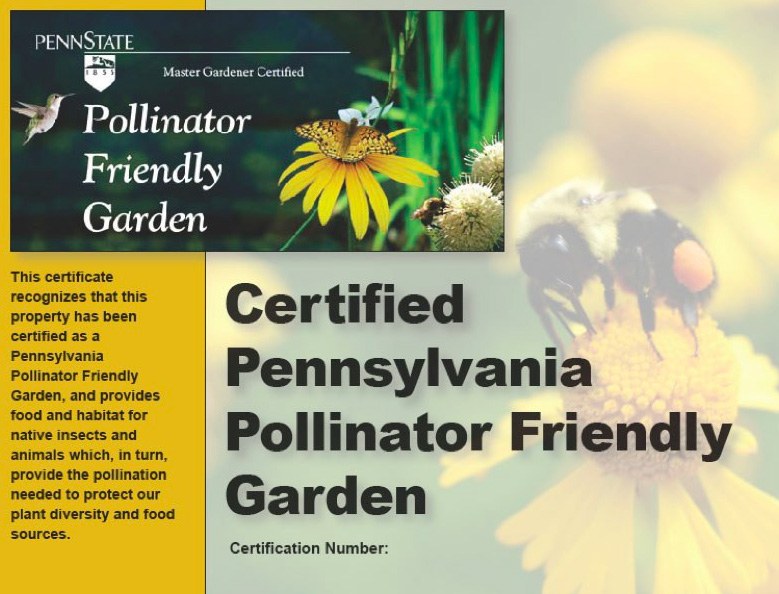Posted: July 29, 2020
Throughout this webinar series, presenters have discussed the diversity of bees and the challenges that they face. Oftentimes people feel as if there isn’t much that they can personally do in order to help bees. However, in the final webinar of the series, Penn State Extension educator Connie Schmotzer discusses how to create a pollinator-friendly environment in your own garden.

The Certified Pennsylvania Pollinator Friendly Garden certificate
Schmotzer goes in-depth about garden certification, practices to avoid, and the best way to maximize survivability for pollinators in your garden. By providing essential resources for bees you can help to actively fight against declining bee populations in your own home. Multiple factors can impact how attractive pollinators will find a particular garden, so it is important to incorporate as many attractive qualities as possible.
Food is the number one resource that a good garden can provide for pollinator species. While bees are the most important pollinators, insects like flies, solitary wasps, beetles, butterflies, moths, and hummingbirds also play an important role in pollination. When creating a pollinator-friendly garden it is important to keep these groups of pollinators in mind as well. Each group has their own unique dietary needs in order to maintain their lifestyles. The best way to provide these resources is to give pollinators access to a plethora of native plants. Native plants have specialized relationships with native pollinators they coevolved with each other, and oftentimes these plants and pollinators are reliant on each other for their survival. Having a high diversity of native plants containing different shapes and nutrients is very useful for maintaining native pollinators, as it allows species with different mouthparts and dietary needs to thrive in the same environment.
Flower color affects how insect pollinators see a garden. Because insects tend to see light on the UV spectrum, they see plant colors differently than humans. Having a variety of flower colors in your garden can be attractive to different insects and aesthetically pleasing for people. It is also important to take foraging time into account. Different bee species emerge and forage at different points in the season but overall the foraging season lasts from March-November. Therefore, in order for bees to have resources throughout the season, a garden should include plants with a variety of bloom times. Gardens should also include flower density to a critical mass to attract pollinators. Picture it from a pollinator's point of view. As they are flying over flower patches, bees are more likely to see a large area of plants versus a single plant. Floral consistency is another important factor to consider because pollinators tend to visit multiples of a particular plant. In general, there should be about five or more of the same flower planted closely together (about 10-12 inches). However, if space is limited, having only three plants is also acceptable. These plants are available for purchase from a variety of nurseries. For a list, go to the website of the Pennsylvania Native Plant Society.
Providing shelter and nesting habitat is another great way to make a garden more suitable for pollinators. The majority of bees are either ground nesters or tunnel nesters. Supplying an area of undisturbed ground with no pesticides is the best way to provide shelter for ground-nesting bees. It is also recommended to avoid using thick turf, compacting the soil, or adding mulch and other landscape materials as ground-nesting bees cannot build a suitable habitat with these in use. Tunnel nesting bees require hollow and pithy stems to lay their eggs in. Providing these bees with plants with pithy or hollow stems, and soft wood such as old tree stumps, is ideal. It is important to safeguard pollinator habitat by removing and not planting invasive plants. As previously stated, native plants are far better for pollinators as many of them have coevolved together. Another way to safeguard pollinator habitat is to not use pesticides. Pesticides can cause a lot of health problems at every stage of the bee's life cycle. If pesticides are completely unavoidable then try applying them when bees are not foraging in the evening and always follow the label directions. Never apply pesticides to flowering plants.
If all of this sounds overwhelming, don't worry. The resources provided will allow you to turn even the smallest of gardens into a beautiful pollinator sanctuary. When creating a pollinator garden feel free to also take into account what you want to see in it. Add things like a table and chairs, lawn art, or other personal touches. Creating a pollinator garden can be as fun as it is rewarding.
Additional resources on creating a pollinator-friendly garden are available down below. Thank you to all of the speakers who donated their time and resources to this webinar series. All webinar recordings are available for viewing!
Written by Ashley Moak
Full webinar descriptions and registration information
For additional questions you can contact Connie Schmotzer
Additional Resources:

